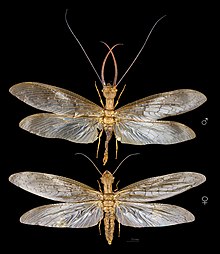
Aquatic insects or water insects live some portion of their life cycle in the water. They feed in the same ways as other insects. Some diving insects, such as predatory diving beetles, can hunt for food underwater where land-living insects cannot compete.

Megaloptera is an order of insects. It contains the alderflies, dobsonflies and fishflies, and there are about 300 known species.
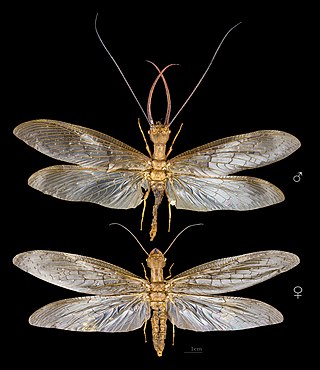
Dobsonflies are a subfamily of insects, Corydalinae, part of the Megalopteran family Corydalidae. The larvae are aquatic, living in streams, and the adults are often found along streams as well. The nine genera of dobsonflies are distributed in the Americas, Asia, and South Africa.

The eastern dobsonfly, Corydalus cornutus, is a large insect in the Corydalidae family. It is found in eastern North America in regions with fast-flowing streams where its aquatic larvae develop. These are known as hellgrammites and are among the top invertebrate predators in the streams in which they live. They are used by anglers as bait.

Corydalus is a genus of large flying insects in the Corydalidae family, commonly known as dobsonflies. They are endemic to North, Central and South America and there are about 35 known species. Members of the genus have wing lengths of up to 85 millimetres. They are sexually dimorphic, with the males having large mandibles used to grasp the females during mating while the females have smaller jaws. The larvae are known as hellgrammites and are aquatic predators.
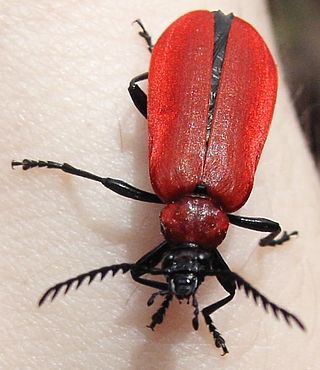
Fire-coloured beetles is the common name for members of the tenebrionoid family Pyrochroidae. The family is found worldwide, and is most diverse at temperate latitudes. Adults measure 2–20 millimetres (0.079–0.787 in); larvae reach 35 millimetres (1.4 in). Larvae of Pyrochroinae are found associated with the bark of dead trees. They are probably mostly fungivorous, although they may become cannibalistic if too crowded.

Fishflies are members of the subfamily Chauliodinae, belonging to the megalopteran family Corydalidae. They are most easily distinguished from their closest relatives, dobsonflies, by the jaws (mandibles) and antennae. In contrast to the large jaws of dobsonflies, fishfly mandibles are not particularly noticeable or distinctive, and the males have feathery antennae similar to many large moths. Chauliodes pectinicornis, the "summer fishfly", is a well-known species in North America.

The Psychomyiidae are a family of tube-making caddisflies. Members of this family are typically very similar to polycentropodids, most of them can be differentiated by the spur formula is 2-4-4, thyridial cell short, absence of the forewing fork I, and hindwing forks I and IV. Male genitalia has elongate preanal appendages, and reduced tergum IX. The larvae differ by the submental sclerites separated, foretrochantin broad, and the pupal mandible apex whip-like. Larvae construct long silken galleries.

Alderflies are megalopteran insects of the family Sialidae. They are closely related to the dobsonflies and fishflies as well as to the prehistoric Euchauliodidae. All living alderflies – about 66 species all together – are part of the subfamily Sialinae, which contains nine extant genera.
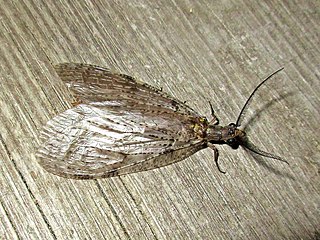
Chauliodes pectinicornis known as Summer fishfly, is a species of fishfly from North America.

Nigronia serricornis has many common names including hellgrammites or fishflies or saw-combed fishflies. The genus Nigronia has one other North American member N. fasciatus and South American which lives in much of the same territory and is quite similar in all regards. They are holometabolous insects with an aquatic larval stage. N. serricornis is a common inhabitant of woodland streams in North America and they are often the largest insect predator found in 2nd and 3rd order streams. The larvae are a sit-and -wait ambush predators that feed on a large variety of invertebrates. Studies have shown that N. serricornis has a varying diet throughout the seasons.

Archichauliodes diversus is an insect in the subfamily Chauliodinae - the fishflies, though it is often referred to as the New Zealand dobsonfly, despite not being a true dobsonfly. In its larval form it is commonly known by the name toe-biter, and its Māori name is puene. The species is native to New Zealand. Although there are many other species of fishfly in other parts of the world, Archichauliodes diversus is the only species of fishfly in New Zealand.
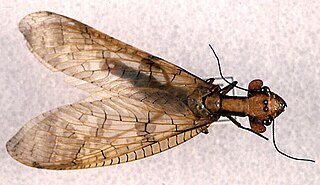
Platyneuromus is a genus of dobsonflies in the family Corydalidae. They are found in Mexico and Central America.

Acanthacorydalis fruhstorferi is a species of dobsonfly native to Vietnam and China. It holds the title of largest aquatic insect by wingspan according to the Guinness Book of World Records at 21.6 cm. The title formerly belonged to the Brazilian damselfly Microstigma rotundatum.

Neoneuromus is a genus of dobsonfly endemic to the Indomalayan realm with 13 species. The larvae breed in montane streams. Adults are large with a forewing of 43 to 68 mm length and the body is yellow to red or brown with black marks on the head and pronotum. The wings are marked in dark patterning in the membrane and along the veins. They are closely related to Nevromus from which they are separated by the attenuation of the ninth sternum with an incised tip.

Chloronia is a genus of dobsonflies in the family Corydalidae.

Taeniochauliodes is a genus of fishflies in the family Corydalidae.

Protohermes is a genus of dobsonflies in the family Corydalidae. Protohermes is the most speciose and widely distributed genus within Megaloptera, but up to 85% of species are restricted to small endemic areas in Asia. This endemism may be a result of an association with high elevation and high slope streams in Northern Vietnam and China.

Parachauliodes is a genus of fishfly in the family Corydalidae. They are present throughout Eastern Asia, likely originating on the Korean peninsula before dispersing to the Japanese archipelago 15 mya.
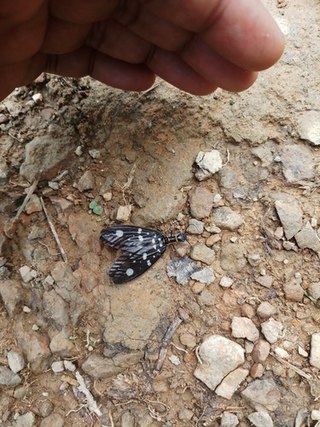
Neurhermes is a genus of dobsonflies in the family Corydalidae.
